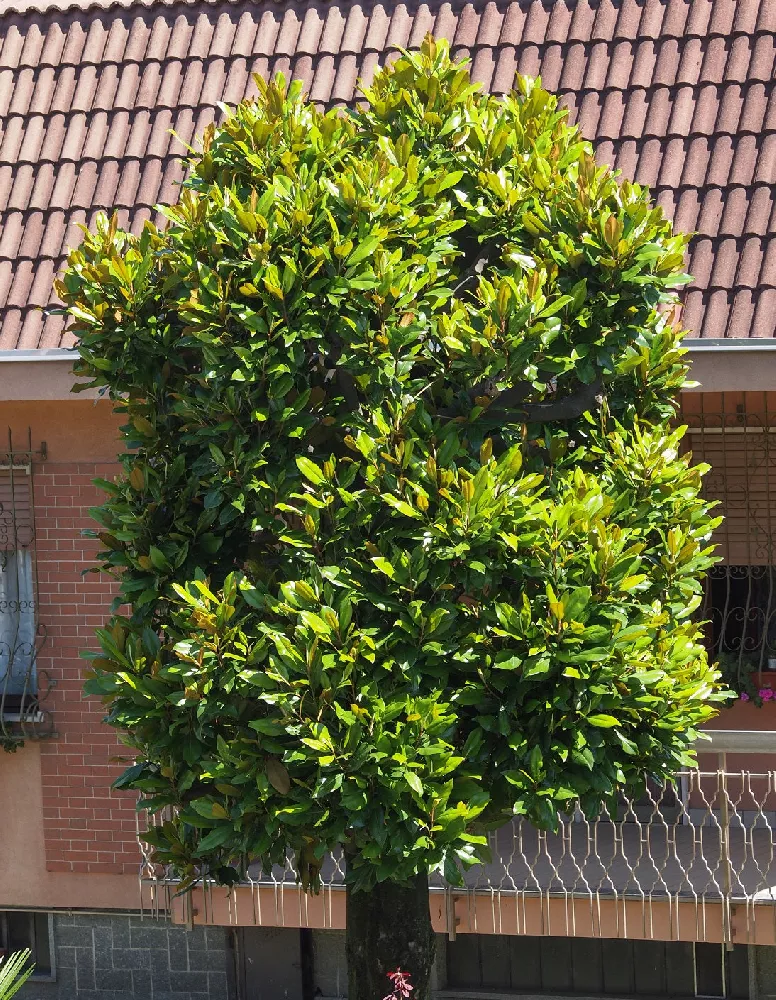- Home >
- Flowers >
- Trees and Plants with White Flowers >
- Kay Parris Magnolia
Kay Parris Magnolia for Sale - Buying & Growing Guide
Magnolia grandiflora 'Kay Parris,' better known as the Kay Parris Magnolia, is a small to mid-sized tree that holds creamy white flowers set against glossy green leaves throughout the entire summer. Those flowers are not only fantastic to look at, but they also offer a pleasant fragrance. The Kay Parris Magnolia is also quite resilient and proves to have the best drought tolerance of nearly any magnolia variety.
- The Kay Parris Magnolia has glossy foliage and white flowers that last all summer.
- Although this plant grows quickly, it maintains a moderate, compact size.
- The Kay Parris Magnolia has better drought tolerance than most magnolias.
Enter your zip code to find nearby stores that may carry this plant.
Plant Care
Sunlight

A Kay Parris Magnolia will grow well in both full sunlight and partial shade.
Watering
Water once per week during establishment. After establishment, water this plant about once or twice per month.
Fertilizing

Fertilize your Kay Parris Magnolia once per year in early spring using a nitrogen-rich fertilizer.
Planting and Care
Planting instructions
The Kay Parris Magnolia Tree can grow in either full sunlight or partial shade. However, full sunlight often makes for the healthiest growth and the best overall appearance. The soil in your planting area should contain plenty of organic nutrients, be slightly acidic and have great drainage. To plant your Kay Parris Magnolia, start by digging a hole that is as deep as the root ball is tall and about twice as wide. After backfilling and watering, cover the planting area with a layer of mulch.
Watering and nutrients
During the establishment period, you should water your Kay Parris Magnolia about once per week to maintain consistent soil moisture. Following the establishment period, you can reduce your watering rate for this plant to about once or twice per month. Regular fertilization will also benefit your Kay Parris Magnolia. The best fertilizers for this plant are those that have plenty of nitrogen. You can feed your Kay Parris Magnolia annually in the early spring, and it should grow just fine.
Pollination
Pollination for magnolia trees is a surprisingly interesting topic. Firstly, since magnolias evolved well before the emergence of many of today’s most common flying pollinator insects, the flowers of a magnolia tree must rely on other insects to conduct pollination. Typically, crawling beetles are responsible for moving pollen from one flower to another. Additionally, you may find that some Kay Parris Magnolias are self-fertile, while others are self-sterile and will need a companion plant to perform pollination successfully.
Pruning
Pruning for the Kay Parris Magnolia Tree should take place in the late summer or early fall when this tree has finished flowering. Pruning earlier in the season risks removing this tree’s blooms since this species sets its flower buds on old wood. Also, pruning during spring is likely to cause this plant to bleed sap. While bleeding sap is not always fatal, it can drastically diminish the overall health and vigor of your Kay Parris Magnolia Tree.
Pests, diseases and animals
There is a wide range of pests that can harm your Kay Parris Magnolia Tree. The most common insects that will cause an infestation in this plant are thrips, aphids, mealybugs, scale insects and caterpillars. Diseases can also be an issue for the Kay Parris Magnolia, and crown gall, leaf spot and powdery mildew are some of the most common. Along with those pest and disease threats, the Kay Parris Magnolia can also experience leaf scorch and iron deficiencies.
Achieving maximum results
While full sunlight is typically best for the Kay Parris Magnolia, those who live in the hotter parts of this plant’s range will be better off using a partial shade location. Full sunlight during a hot summer can scorch the leaves of a Kay Parris Magnolia. You should also be careful in general when choosing a growing location for this plant. Since the Kay Parris Magnolia has sensitive roots, it does not usually respond well to transplanting.
FAQs
What do the flowers of the Kay Parris Magnolia look like?
The flowers of a Kay Parris Magnolia Tree consist of large, creamy white petals that open around a textured yellow center. These lovely flowers are also quite fragrant and have a relatively large size, measuring about 10 inches across at times. The flowers of the Kay Parris Magnolia are also long-lasting, as they persist on the tree during the entire summer season.
Where does the Kay Parris Magnolia come from?
The Kay Parris Magnolia is a relatively new magnolia cultivar. It came into existence in 1991 in South Carolina. From the onset, the Kay Parris Magnolia variety boasted fantastic flowers and a shape that is a bit more compact than other magnolia trees. Along with those features, the Kay Parris Magnolia also has great drought tolerance and the ability to grow in either full sunlight or partial shade settings.
Is the Kay Parris Magnolia evergreen?
While some magnolias are deciduous and will lose their leaves each fall, other magnolias are evergreen. The cultivar we know as the “Kay Parris Magnolia” belongs to the second group. The leaves of this plant are somewhat long with a pointed end and remain on the branches all year. The foliage also has a lovely glossy texture that gives off a shine that perfectly complements the flowers in summer.
Compare Similar Products
You can't add more Product Name - Product size to the cart.
OK









